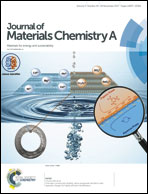Tuning the aggregation of graphene oxide dispersions to synthesize elastic, low density graphene aerogels†
Abstract
Sol–gel processing of graphene oxide (GO) dispersions is the most common method to prepare graphene aerogels. However, the variability in graphene aerogel properties and the incomplete understanding of GO dispersions have both been obstacles to widespread application of graphene aerogels. Here, we show that the properties of graphene aerogels are strongly dependent on the force balance that determines GO dispersion stability prior to gelation. This insight leads to an improved synthesis method that consists of annealing GO at low temperatures prior to a standard hydrothermal process. The resulting enhancement in π–π interactions can be used to modulate the degree of GO aggregation in water, which can weaken hydrophobic attraction during gelation. This route leads to ultra-low density graphene aerogels with an elastic mechanical response and a tuneable pore size. Graphene aerogels produced by this method show excellent compressibility and can be used as reusable oil absorbents and as strain sensors. The modified synthesis with a low-temperature annealing step is facile and scalable, and attractive for large-scale production of ultralight elastic graphene aerogels.



 Please wait while we load your content...
Please wait while we load your content...